January 4, 2019

Taking on invasive species requires targeted and aggressive action. The Washington State Department of Agriculture has been working hard to limit the spread of the gypsy moth, a tree-eating parasite. As part of that effort, each year WASDA officials identify key treatment areas.
For 2019, the department plans to treat several areas in western Washington to eradicate several introductions of the moth. This non-native moth can decimate the environment with its voracious appetite. The proposal calls for treating about 1,700 acres of land at four sites, including one side where WSDA trappers detected an Asian gypsy moth — the first since 2015.
WSDA’s proposal involves aerial applications of a soil bacteria called Bacillus thuringiensis var. kurstaki, or Btk. This is an insecticide approved for use in organic agriculture. In its press statement about the treatment, the agency noted that Btk has “an excellent safety record around people, plants, pets, fish, birds and trees, and has been used globally for decades as a safe and effective treatment for combating gypsy moth.
Treatments occur as the caterpillars for the moth emerge in the spring and begin to feed on vegetation. Aerial treatments are proposed for the Union Hill-Novelty Hill area in King County, the community of Martha Lake in Snohomish County, and the communities of Gilbertson and Crosby in Kitsap County.
Gypsy moth caterpillars dine on hundreds of trees and shrubs, often killing these plants in neighborhoods, parks and forests. The pest destroys wildlife habitat. For example, moth-damaged tree canopies can degrade water quality in streams. An infestation can also trigger a quarantine for timber, Christmas trees, and other forestry and nursery products.
Trap results
In summer 2018, WSDA trapped 52 gypsy moths — 51 European gypsy moths and 1 Asian gypsy moth. More destructive than its cousin, the Asian gypsy moth feeds on a wider variety of trees; also, the Asian gypsy moth female can fly, so populations can spread more quickly and do more damage to the environment.
The next steps in this process for WSDA is to prep for two environmental reviews; consult with local, state and federal agencies; and reach out to the public, which includes informational open houses in affected communities. Residents in or near the areas where treatment is proposed will receive postcards notifying them of the proposal. WSDA will also post regular updates at its gypsy moth webpage, including maps, specific information on treatment areas and public comment opportunities.
Initially detected in 1974, no permanent populations of gypsy moths have been established due to WSDA’s successful trapping and treatment program.
Source: WSDA
You May Also Like




